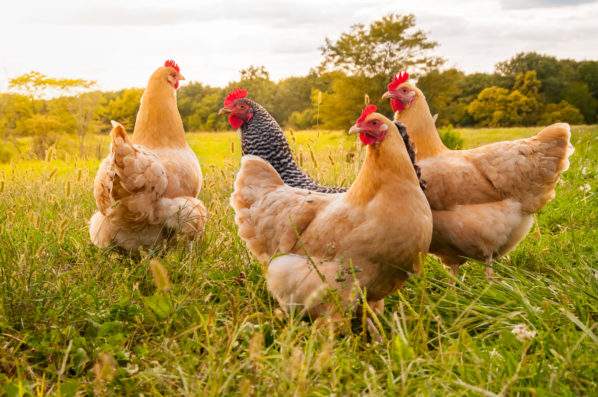Inspired By Chicken’s Natural Resistance To One Chemical, Stanford Medicine Researchers Developed A New Custom Drug That May Be A Viable Opioid-Free Postoperative Pain Therapy

According to the American Academy of Family Physicians, one in four people who receive an opioid prescription for chronic, noncancer pain struggle with opioid dependence. This fact has pushed both physicians and patients alike to explore other non-opioid treatments and therapies.
A recent study conducted by Stanford Medicine researchers has also made new headway in this space– discovering a possible new pain treatment that does not involve opioids.
The team specifically targeted the region of a well-known pain receptor, and in doing so, they were successful in reducing pain sensitivity in mice without impacting other receptor functions.
The inspiration for this study also came from one unsuspecting animal: chickens.
Chicken farmers are aware that mice and squirrels will not eat any chicken feed that’s laced with capsaicin– which is actually the chemical that makes chili peppers spicy.
When consumed by mammals, capsaicin promotes a burning sensation by activating a pain receptor. Among most aviary species, though, capsaicin has little to no effect.
“It turns out that birds are naturally resistant to capsaicin,” explained Eric Gross, an associate professor of anesthesiology, pain, and perioperative medicine.
Upon learning this, Gross began to wonder if humans could also have a genetic variant that would render the receptor– known as TRPV1– more resistant to pain.
And in a new study published in the Journal of Clinical Investigation, the researchers successfully identified a distinct genetic variant of TRPV1 that is able to reduce human pain sensitivity. Plus, despite this variant being extremely rare, the researchers were still able to replicate the altered gene’s effects to create a custom drug.

Moonborne – stock.adobe.com – illustrative purposes only
To do this, the researchers utilized a computational approach to locate human genetic variants of TRPV1 that resembled TRPV1 in birds. Then, once the team tested these variants using genetically modified cells, one specific variant stood out from the rest.
The variant, K710N, was found to drastically reduce the pain receptor’s reaction to capsaicin. And according to Gross, this was an unbelievable discovery.
“We were quite amazed that there was such a decrease in the activity of TRPV1’s response to capsaicin when we made that genetic variant. It was to the point where we actually tried this several times to make sure that was really what we were seeing,” he said.
Afterward, the researchers used a gene-editing technique known as CRISPR/Cas9 to create mice that had the K710N mutation.
The team’s plan was to determine whether the mice would consume the capsaicin-laced bird food that typical mice refuse to eat.
The scientists ultimately observed how immediately after the spicy bird food was placed out for the mice, the normal mice tried to avoid touching capsaicin as best as they could. The mutated mice, however, were able to tolerate the capsaicin– and they even sampled a bit of the spiced bird food.
So, by analyzing these differing behavioral responses, Gross and his team estimated that the K710N mutation was able to reduce pain by approximately 50%.
The Science Of Pain Reduction
It is crucial to underscore that the TRPV1 receptors in human sensory neurons are responsible for a lot more than just generating a spicy sensation when we consume chili peppers. Instead, they also regulate body temperature and protect us from danger by responding to other stimuli– including physical injury and heat.
So, according to Gross, it would be unwise to take away anyone’s full ability to sense pain.
“You still want to have somebody, if they place their hand over a hot stove or step on a Lego, to have that pain sensation,” he noted.
This means that the K710N mice represent a good middle-ground. While they felt less pain, they were still able to maintain body temperature and sense potentially harmful stimuli.
Additionally, TRPV1 is responsible for even more functions in the human body– for instance, protecting us from organ damage.
In the study, though, the researchers found that the K710N variant did not just retain these functions but actually enhanced some of TRPV1’s protective benefits. For instance, heart cells that had the variant were actually less likely to die following temporary oxygen deprivation.
Custom Chronic Pain Drug
Equipped with these findings, the researchers then decided to design a custom-made drug that yielded the same effect as the K710N mutation.
The drug is a peptide known as V1-cal. And when it was administered to the mice– either via infusion or injection– the mice experienced less chronic pain from nerve injury and reduced capsaicin sensitivity.
Plus, the drug was found to have little impact on body temperature regulation and heat sensation.
TRPV1 has been a target for pain treatments in past research. However, Gross claims that the new drug is more selective and results in fewer side effects.
“People have always used a direct approach, so they looked at ways to specifically activate or block the receptor. That’s been a challenge because activation of the receptor causes pain, while inactivation may cause unwanted changes in body temperature,” Gross detailed.
In their study, though, Gross and his team did not focus on directly activating or inactivating the pain receptor. Instead, the new drug modulates one specific region of the receptor– and in doing so, the side effects can be circumvented.
“We are able to avoid the side effects that have been plaguing drug discovery for TRPV1 for quite some time,” Gross said.
Now, he and his team are eager to modify the peptide– making it more stable in hopes of relieving pain longer. Their ultimate goal is to see if this new drug would work as an opioid-free postoperative pain therapy.
To read the study’s complete findings, visit the link here.
If true crime defines your free time, this is for you: join Chip Chick’s True Crime Tribe
Sign up for Chip Chick’s newsletter and get stories like this delivered to your inbox.
More About:Science





